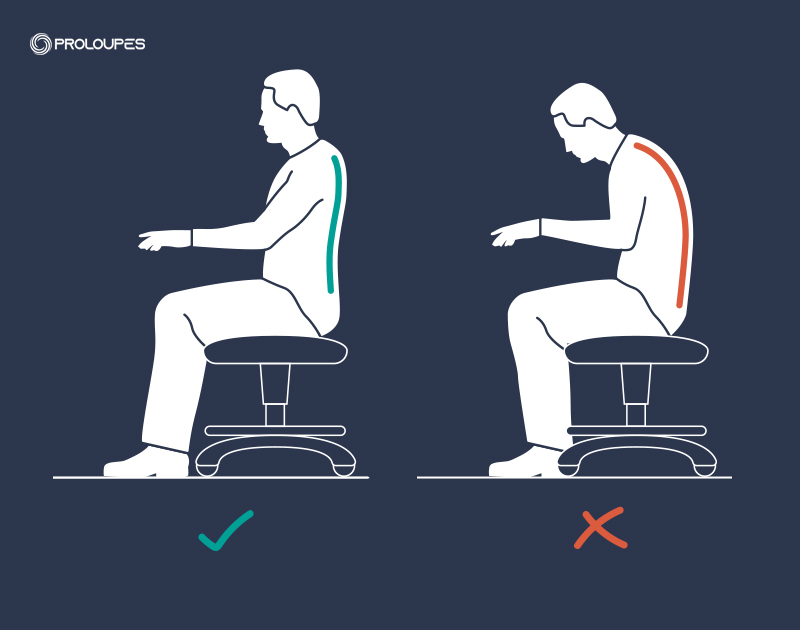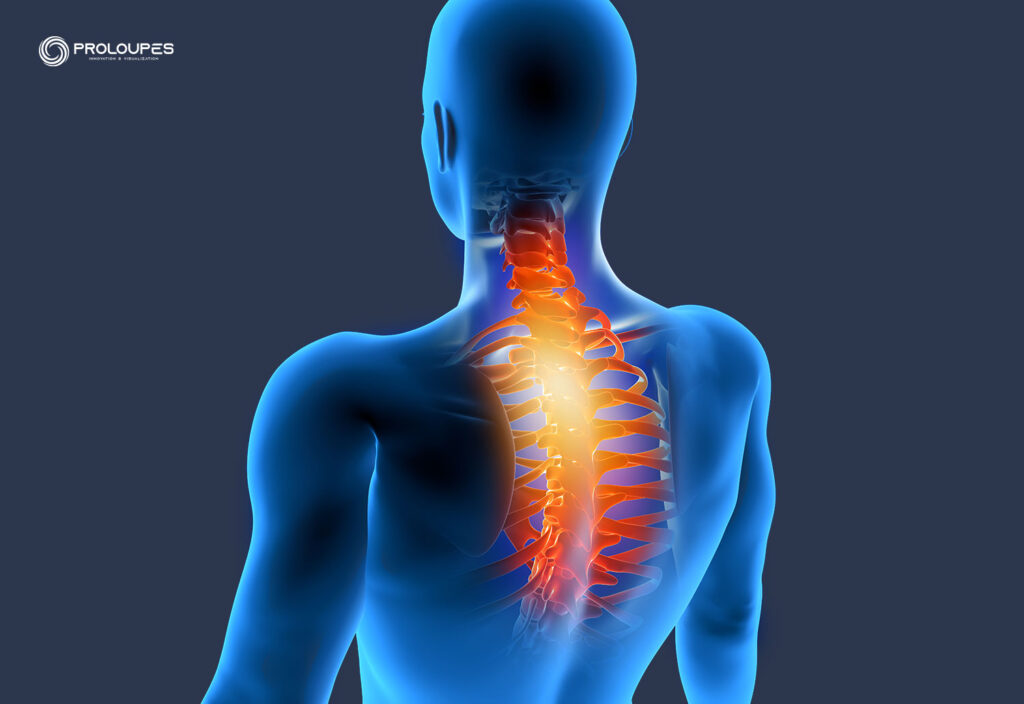Musculoskeletal Disorders Among Dentists
Musculoskeletal disorders (MSDs) are injuries and disorders affecting muscles, nerves, tendons, ligaments, joint cartilage, or spinal disc. They are the most important work-related problems currently reported among dentists. (1) Occupational health in dentistry deals with the prevention of musculoskeletal problems, especially in the cervical and lumbar spine. Ergonomics in dentistry aims to learn about human abilities and the dentist’s work environment to reduce the risk factors of musculoskeletal pain.

Prevalence and Distribution of Musculoskeletal Symptoms Among Dentists
The incidence of neck and back pain among dentists is higher than the general population. This may be attributed to extreme postures that may be assumed during clinical work. (2) Various studies present similar data of incidence and distribution of musculoskeletal pain among dentists: Out of 100 dental students, 73% reported pain with the following distribution: neck (82%), back (72%), shoulder (62%), arm (34%), hands (31%), and legs (3%). Half of them were treated with physiotherapy and 20% took painkillers. (1)
Dr. Kumar (2019) surveyed 130 dentists and found that 89% of them reported at least one musculoskeletal complaint in the past 12 months. The most prevalent sites with symptoms reported were the neck (67%), shoulders (58%), and lower back (51%). (3) Magdalene (2019) found that 56.4% of dentists had suffered neck pain for 10–15 years. 33.6% had pain along the side of the neck, 31.8% had numbness along the medial side of the arms, and (21%) complained of back pain. 49.1% of dentists seek medical care for neck pain, and 57.3% are undergoing physiotherapy. (4)
“Dentists are at risk for musculoskeletal problems, mainly due to poor ergonomics affecting their neck and lower back.” This is the main finding of a survey conducted by the American Dental Association (ADA) on 7,475 active dentists. Two-thirds of the respondents reported that they suffered from neck pain and back pain and nearly half of them said that it was either moderate or severe in its intensity. (5)
Risk Factors for Musculoskeletal Problems Among Dentists
According to Dr. Douglas Wolff, the main risk factors for musculoskeletal
Problems among dentists include:
- The practitioners’ seated posture if the patient chair does not allow them to easily access the oral cavity
- Bending, twisting, and assuming awkward positions when treating the patient
- Prolonged muscle contraction
- Repetitive motion
- Limited space to maneuver in the clinic
- Poor intraoral lighting leads to perching on the edge of the operator stool and peeking into the oral cavity
- Instruments that are not properly sharpened require more exertion in order to be effective
94% of respondents engaged in physical activity during the week, so the most important practical emphasis for reducing neck and back pain lies mainly in ergonomics. (5) The degree of neck region overload depends on the technique used by the dentist, the ergonomic conditions, patient adaptation skills, and cooperation with the assistants. Answers to an anonymous questionnaire from 52 dentists found that half of them indicate that pain in the neck region is caused by long-lasting maintenance of a static position of the body. (6)
A cross-sectional study of 8,303 dentists with 12 consecutive months of practice in Taiwan found that dentists who were female and of older age, had comorbidities of insomnia, depression, and anxiety associated with MSDs. (7)

Ergonomic Intervention and Recommendations
The meaning of posture in ergonomics is the manner in which different parts of the body are located. Consequently, reports are established between the body parts in order to allow a special task execution. The posture described in ISO Standard 11226 Ergonomics – Evaluation of static working postures outlines recommendations for dentists to achieve a balanced or neutral posture. The characteristics of “balanced posture” include the following principles:
- Symmetrical seating.
- A straight back – avoiding rounding the back into a “C” shape.
- Forward inclination of the trunk to a maximum of 20°- a greater forward
inclination, the tilting to a side, and the trunk rotation are contraindicated.
- Forward inclination of the head up to 20-25° from the trunk.
- Arms placed along the body, forward oriented within 10°, the forearms
raised up to 25° from the horizontal line.
- The angle between the thighs and calves of 105-110° or more.
- Thighs being up to 45° apart, avoiding a rigid fixation of the hip joint.
- Calves oriented perpendicular to the floor or slightly posterior.
- Feet on the floor-oriented forward in the same plane with the calves.
When the feet are symmetrically positioned below the operator’s hands, the posture is balanced. (8,9)
- A sitting posture with a slight anterior pelvic tilt and a slight lumbar lordosis reduces the incidence of low back pain most efficiently. ( 10)
- Therapeutic exercises (6) and McKenzie exercise approach. (5)
Vaziri et al (2018) recommended teaching that suitable body posture, regular rest breaks, and doing stretching exercises between working hours can reduce and prevent musculoskeletal harm in dentists, especially in the neck and shoulder regions. (11)
How to Reduce Neck Flexion
Since neck flexion is the most commonly associated cause of neck pain among dentists, it has been shown in previous studies that wearing loupes improves neck posture. (1) The loupes should be personally “tailored” to the dentist. It is necessary to determine the magnification level, working length, field of view, and angle of declination, to maintain proper head and neck posture. (5) A recent study among 400 dentists and students found that the use of loupes was associated with lower levels of musculoskeletal disorders in the lower back, neck, shoulders, elbows, upper back, and feet. (12)
Seeing Better May Lead to Better Treatment Outcomes and Less Musculoskeletal Effort
Magnification can help improve ergonomics and treatment outcomes. (13,14) It is important that the loupes be lightweight so that they remain stable on the bridge of the nose and do not ride down the nose. Properly adjusted loupes may prevent and reduce the severity of neck and back pain. In addition, it was found that among dentists who wore loupes there was better stabilization of the proximal joints like elbows and shoulders which led to better distal function of the finger joints and wrists in the fine motor skills needed for treatment. Therefore, a growing number of dental schools are embracing magnification as being important in the dental education process. (15)
Sitting in a more upright posture is better from an ergonomic standpoint as the dentists will have less fatigue in both the lower (back) and upper spine (neck and shoulders). It is nearly impossible to achieve a straight forward vision (as can be obtained with the operating microscope), and, if neck and back pain is severe for a dentist, loupes may lessen pain severity if properly adjusted. (15)
In Summary
Magnification should be considered a must for all dental practitioners, regardless of age or visual acuity. The native resolution of the human eye limits our ability to visualize the details that are so crucial to delivering clinical excellence. (15)
Prevention: Stopping Pain Before it Begins is Always Best
Dentists should focus on how they work, how they hold instruments and how neck and back posture could be contributing to their aches. (5) Dentists should be educated about ergonomics at the beginning of their professional life. A questionnaire aimed at examining risk factors associated with work-related musculoskeletal disorders in dentistry found that two-thirds of the 163 respondents reported back and neck pain. The intensity of the symptoms was higher in women, especially in the wrist, and neck pain was less common in older dentists. A possible explanation is that experienced dentists are better at adjusting their working position and techniques in order to avoid musculoskeletal problems when compared to their less experienced colleagues. (16) Another questionnaire-based study conducted among 100 undergraduate dental students found that most of the students were not aware of the ergonomic principles and their effect on musculoskeletal pain. The prevention and reduction of MSDs among dentists should include their education in dental ergonomics and awareness regarding the importance of work-related risk factors. (17)
A new study demonstrated dentistry students have little knowledge about ergonomics and the possible development of musculoskeletal diseases while still in the undergraduate course. (18)
References
- Oviya, V. J., & Thenmozhi, M. S. (2018). Awareness on the effects of ergonomics interventions on work-related upper extremity musculoskeletal disorders among undergraduate dental students. Drug Invention Today, 10(12).
- Shetty, S. M., Shetty, S., Hegde, A., & Babu, N. (2015). Prevalence of neck and back pain among pediatric dentists. Nitte University Journal of Health Science, 5(1), 45.
- Kumar, R. P., Saraswathi, S., & Thangavelu, L. (2019). Prevalence of musculoskeletal disorder and experience among dental practitioners in Chennai-A cross-sectional survey. Drug Invention Today, 12(1).
- Magdalene, M., & Premavathy, D. (2019). Prevalence of neck pain among dentists. Drug Invention Today, 12(8).
- ADA Wellness Survey reveals dentists’ ergonomic issues. January 12, 2018
- Płocki, J., Pikuła, D., Banaś, J., & Kotela, A. The effect of ergonomics in dentistry on the occurrence of pain in the cervical neck region of the spine. Medical Studies/Studia Medyczne, 31(1), 35-41.
- Li, S. F., Hung, C. T., Wu, C. M., & Lee, M. W. (2020). Prevalence and related factors of musculoskeletal disorders among dentists in Taiwan: a cross-sectional study using the National Health Insurance Research Database. 台灣公共衛生雜誌, 39(4), 453-463.
- Pîrvu, C., Pătraşcu, I., Pîrvu, D., & Ionescu, C. (2014). The dentist’s operating posture–ergonomic aspects. Journal of Medicine and Life, 7(2), 177.
- Hokwerda O. Symposim: Ergonomic principles for pacient treatment, Syllabus paper, 2004, Timiçoara.
- Gouvêa, G. R., Vieira, W. D. A., Paranhos, L. R., Bernardino, I. D. M., Bulgareli, V., & Pereira, A. C. (2018). Assessment of the ergonomic risk from saddle and conventional seats in dentistry: A systematic review and meta-analysis. PloS one, 13(12), e0208900.
- Vaziri, F. et. al (2018). Investigating the effect of educational intervention on musculoskeletal disorders in dentists. World Family Medicine Journal: Incorporating the Middle East Journal of Family Medicine, 99(5832), 1-7.
- Aboalshamat, K., Daoud, O., Mahmoud, L. A., Attal, S., Alshehri, R., Bin Othman, D., & Alzahrani, R. (2020). Practices and Attitudes of Dental Loupes and Their Relationship to Musculoskeletal Disorders among Dental Practitioners. International Journal of Dentistry, 2020.
- Branson BG, Bray KK, Gadbury-Amyot C, et al. Effect of magnification lenses on student operator posture. J Dent Educ. 2004;68:384-389.
- Maillet JP, Millar AM, Burke JM, et al. Effect of magnification loupes on dental hygiene student posture. J Dent Educ. 2008;72:33-44
- Glenn A. van As, BSc, DMD (2013) Magnification Alternatives: Seeing is Believing, Part 1
- Bozkurt, S., Demirsoy, N., & Günendi, Z. (2016). Risk factors associated with work-related musculoskeletal disorders in dentistry. Clinical and Investigative Medicine, S192-S196.
- Oviya, V. J., & Thenmozhi, M. S. (2018). Awareness on the effects of ergonomics interventions on work-related upper extremity musculoskeletal disorders among undergraduate dental students. Drug Invention Today, 10(12).
- Brito Rocha (2020). Occupational diseases and ergonomic principles aimed at training dentistry professionals. Revista Salusvita. Vol. 39 Issue 2, p337-351. 15p.
